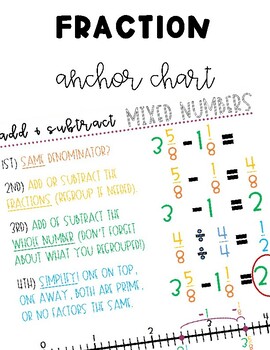Adding and Subtracting Mixed Numbers | Anchor Chart | Number Line | Model
- PDF
What educators are saying
Also included in
- Introducing our comprehensive Fourth Grade Math Mega Bundle – your one-stop solution for mastering all the fourth-grade math standards! This bundle combines all the digital step-by-step instruction products from our collection, offering a treasure trove of resources to support your students' math lePrice $63.00Original Price $71.50Save $8.50
Description
This anchor chart is perfect for introducing how to add and subtract mixed numbers. It has 4 steps outlined with a color coding to match the examples to help students see the correlation. The students will be able to see how to use a model, number line, and standard algorithm.
Anchor charts great learning tools for the teacher and the students! They help students refer back to their learning goals, follow steps and procedures, and help guide their learning. They use math vocabulary as well as student friendly language. It is a great step-by-step way to help students master their math standards!
You can project the anchor chart onto a wall or SmartBoard so that the template can be traced directly onto anchor chart paper. You can also print these in black and white on your favorite colored card stock to hang around your classroom. They are in color so that you have some more ideas when creating your anchor charts with your favorite markers!




